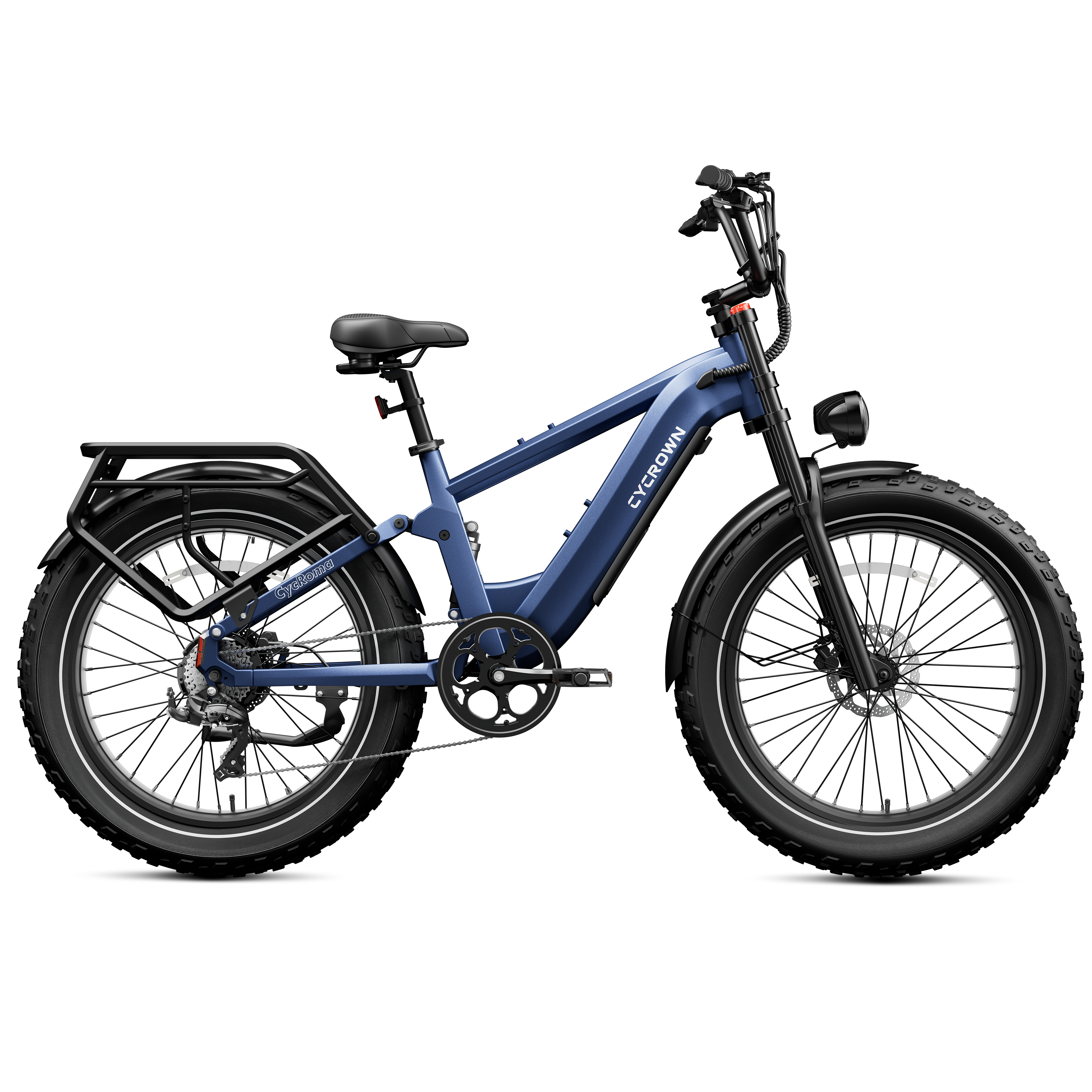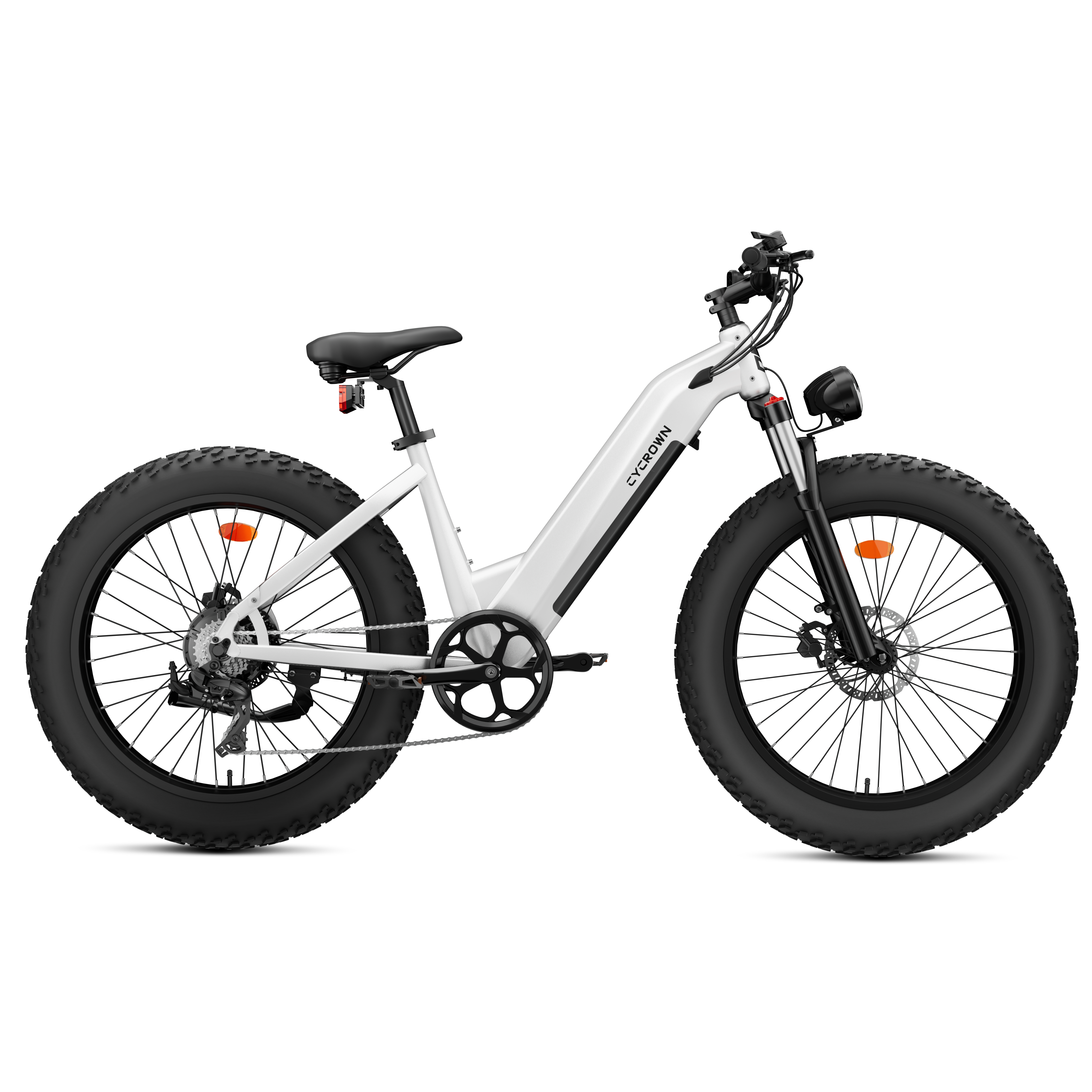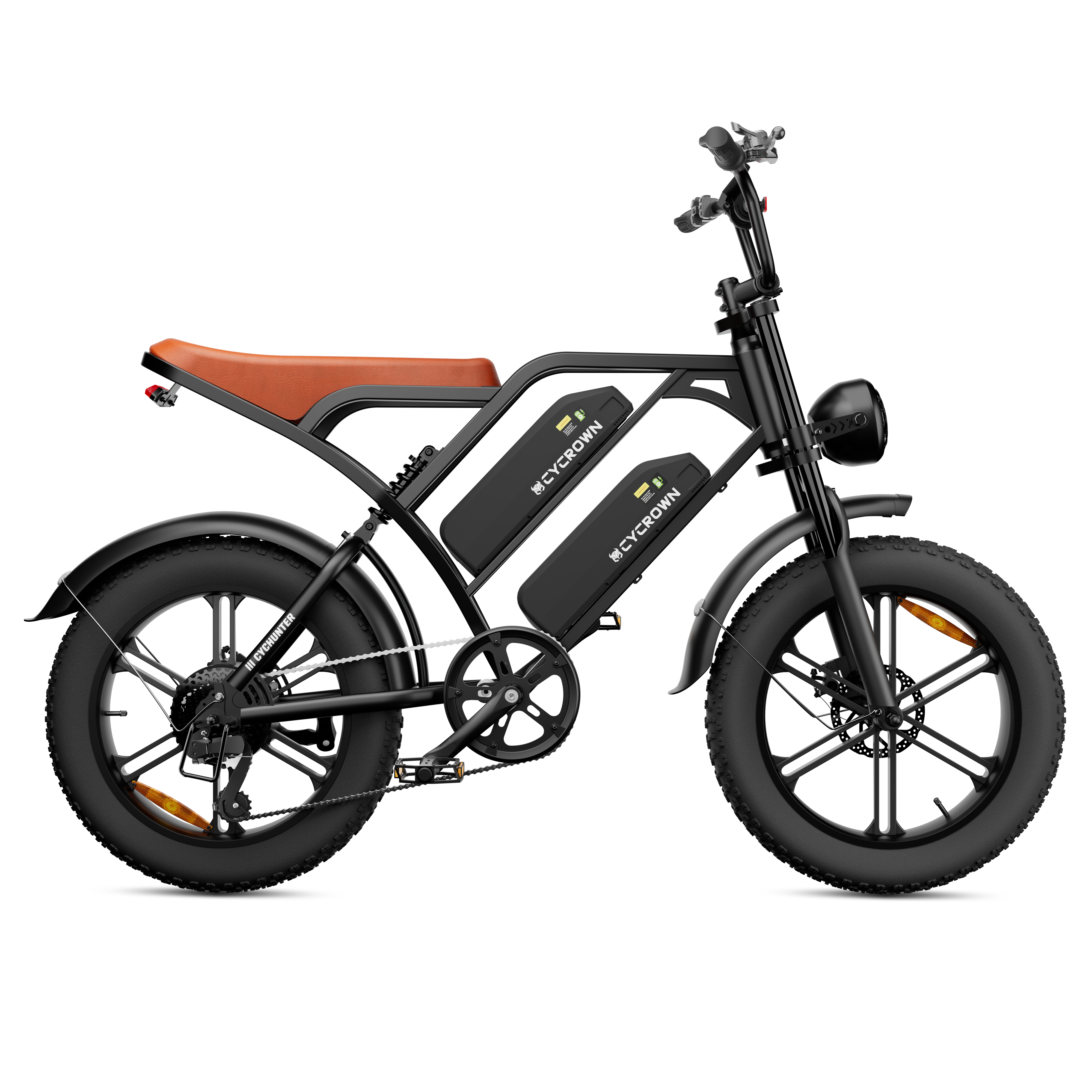Getting the right electric bike tire pressure is vital for a smooth and safe ride.
As a general rule, your e-bike tire pressure should be 35-65 PSI for a mountain e-bike, 110-125 PSI for a road e-bike, and 75-100 PSI for a city electric bike.
Check your tire's sidewall for the specific pressure range and adjust accordingly. Use a pressure gauge to keep it spot on for your bike type and the roads you travel. Want to learn how to keep your tires rolling perfectly? Read on for easy tips!
Why Maintaining the Correct E-Bike Tire Pressure Matters

Proper tire pressure is important for several reasons.
Comfort is a major factor; well-inflated tires absorb shocks better.
Grip and traction are also enhanced, allowing for safer rides on various surfaces.
Additionally, rolling resistance decreases, meaning less effort is required to pedal, leading to increased battery life and efficiency.
Riding with the correct pressure can extend the lifespan of your tires by reducing sidewall wear.
Incorrect tire pressure can cause issues.
Under-inflation can lead to poor handling and increased chances of flats or punctures.
Over-inflation, on the other hand, reduces grip and traction, making the ride uncomfortable.
Always make sure to check the manufacturer's recommended pressure range, usually printed on the tire sidewall.
Factors That Determine Optimal Tire Pressure
Several factors determine the best tire pressure for your e-bike.
First, rider weight plays a critical role. A heavier rider will need higher pressure to maintain the tire's shape and performance.
Tire size is another factor; for example, mountain e-bikes typically have wider tires that require different pressures compared to road e-bikes.
Weather and temperature should also be considered.
Hot conditions can increase tire pressure, while cold weather may require additional air.
The type of terrain you're riding on is crucial too. Off-road trails need lower pressure for better grip, while smooth roads benefit from higher pressure for better speed and efficiency.
Front and back tire pressures may also need to be adjusted differently based on your riding style. Generally, the rear tire bears more weight and might need a slightly higher pressure than the front.
Pressure Monitoring and Adjustment Tools
To maintain optimal pressure, accurate monitoring tools are essential.
A reliable pressure gauge is a must-have. Digital gauges offer precise readings, while analog gauges are durable and easy to use.
Air pumps equipped with built-in gauges can also be convenient for regular checks.
To easily adjust your tire pressure, keep a portable pump handy. For long rides or commutes, consider carrying a small gauge and pump.
Ensure you know how to use both Schrader and Presta valves, as e-bikes can have either type.
Related read: Electric Bike Safety: Tips for a Safe and Enjoyable Ride
Tips for Managing Electric Bike Tire Pressure 
Proper e-bike tire pressure is key to ensuring comfort, performance, and control while riding your electric bike. By managing the pressure based on your riding style, terrain, and weather conditions, you can enhance your overall riding experience.
Regular Pressure Check-Ups
Regularly checking your tire pressure ensures that your electric bike tires are properly inflated.
Underinflated tires can reduce speed and make pedaling harder.
Use a reliable tire gauge to inspect your tire pressure. Most electric bike tires clearly state their recommended PSI range on the sidewall.
Check your tires at least once a week, or before any long trip.
Adjusting Pressure for Various Riding Styles
Different riding styles require different tire pressures. Adjusting your tire pressure based on the riding style can significantly impact your comfort and performance.
For road biking, higher pressures (110-125 psi) reduce rolling resistance, allowing for faster rides on smooth surfaces.
Mountain biking, however, demands lower pressures (35-65 psi) to improve traction and absorb shocks from rough terrain.
For city riding, moderate pressures (75-100 psi) balance speed and comfort.
The Impact of Weather and Temperature
Weather and temperature can affect your tire pressure. Cold temperatures can cause tire pressure to drop, making it important to check and adjust your PSI more frequently in winter.
In wet weather, slightly reducing tire pressure can enhance traction and control on slippery surfaces.
Be mindful of temperature changes throughout the day as they can also influence your tire pressure.
Always adjust your tire inflation to accommodate these variances to maintain stability and ride quality.
Inflation Techniques for Optimized Riding Experience
Inflating your electric bike tires correctly is crucial for an optimized riding experience.
Start by removing the valve cap and pressing the tire gauge onto the valve stem to check the current pressure. If the pressure is too low, use a suitable pump to inflate the tires to the desired PSI.
When inflating, ensure that you do not exceed the maximum pressure indicated on the tire sidewall to avoid over-inflation.
For precise inflation:
- Use a tire gauge to monitor pressure.
- Inflate slowly, checking the gauge often.
- Ensure the valve stem is securely closed after inflating.
Preventative Actions for Tire Longevity

Maintaining your electric bike tires involves regular inspections, understanding how tires degrade, and using sealants to prevent punctures.
Consistent Tire Inspection and Care
Regular checks can help avoid unexpected flats. At least once a week, inspect your tires for sharp objects, cracks, or wear on the sidewall.
Ensure the tire pressure is within the recommended range, which ranges from 40-65 PSI for most e-bike tires. Keep your tires clean. Dirt and debris can hide potential issues and accelerate wear.
Use a soft brush to remove grime and a damp cloth for stubborn dirt. Additionally, rotating your tires can evenly distribute wear and extend the life of both tires.
Understanding and Mitigating Tire Degradation
Tire degradation is influenced by various factors such as rider weight, terrain, and tire pressure. Regularly riding on rough trails or being overweight can accelerate wear, leading to unsafe conditions.
Monitor for signs like thinning tread, sidewall cracks, or frequent pinch flats. If you notice these, it's essential to replace your tires promptly. Riding on compromised tires can result in blowouts or rim damage.
Choosing high-quality tires that suit your riding conditions also reduces degradation. For instance, if you often ride on rocky terrain, consider tires designed for mountain biking over road tires.
Effective Use of Sealants and Puncture Prevention
Using tire sealant can prevent flats effectively. Sealants work by filling small punctures as they occur. This is especially useful for preventing flats from tiny sharp objects like thorns or glass shards.
When applying sealant, follow the manufacturer's instructions. Typically, you need to remove the valve core, inject the sealant, and re-inflate the tire.
Check the sealant level every few months, as it can dry out over time and may need replenishment.
Additionally, you can use tire liners or thicker tubes to add a protective layer inside the tire, reducing the likelihood of punctures and extending tire longevity.
E-Bike Tire Specifications and Variations

Choosing the right tire for your e-bike significantly influences your ride quality, including traction, rolling resistance, and safety.
Exploring Tire Types and Their Unique Characteristics
Electric bike tires come in various types suited for different riding conditions.
Road tires are slim and designed for paved surfaces, offering low rolling resistance.
Mountain bike tires have deep treads for better grip on rough terrain.
Fat tires are wide and great for snow and sand due to their increased surface area.
Hybrid tires combine elements of road and mountain tires for versatility.
Selecting the right tire type depends on your usual terrain and riding needs.
Related read: Your Complete Guide to Fat Tire Electric Bikes
Pros and Cons of Fat Tires and Hybrid Tires
Fat tires offer excellent traction on loose surfaces like snow and sand, thanks to their wide, knobby treads.
They provide a smooth ride over bumps but have high rolling resistance, which can reduce speed and battery life.
Hybrid tires balance features from both road and mountain bike tires.
They offer moderate traction and rolling resistance, making them ideal for mixed-terrain rides.
While they may not perform as well as specialized tires in specific conditions, they are versatile for varied riding environments.
E-Bike Tire Storage and Preservation

Proper tire storage is essential to extending the life of your ebike tires. This includes preparing the tires before storage, choosing the right environment, and applying protectants.
Guidelines for Pre-Storage Preparation
Before storing your ebike tires, clean them thoroughly to remove dirt and grime. Also, make sure the tires are completely dry to prevent mold growth. Then, deflate the tires partially to reduce stress on the rubber but keep enough air to maintain their shape.
Steps:
- Clean the tires with a mild soap.
- Rinse and dry completely.
- Partially deflate the tires.
Selecting the Best Environment for Tire Storage
Choose a cool, dry, and dark place to store your ebike tires. Stable temperatures help prevent rubber degradation. Avoid places with direct sunlight, high humidity, or extreme temperatures.
Recommended conditions:
|
Factor |
Ideal Condition |
|
Temperature |
50-70°F (10-21°C) |
|
Humidity |
Low |
|
Sunlight |
None (completely dark preferred) |
Applying Protectants and Preservatives
Using protectants can shield your tires from ozone and UV damage. So, apply a thin layer of tire protectant, ensuring it is compatible with bike tires. Avoid petroleum-based products as these can degrade rubber.
Protectant application:
- Choose a water-based silicone protectant.
- Apply evenly with a soft cloth.
- Avoid over-saturating the rubber.
Don’t forget tp read our article: The 8 Common Types of Ebikes: A Full Guide
Conclusion
To sum it up, keeping the tire pressure just right on your electric bike is key for a smooth, safe, and less power-consuming trip. Check your tire pressure often and adjust it based on where and how you ride to get the most out of your e-bike. The right PSI can also help your bike last longer and run better.
No matter if you ride every day or just on weekends, the right tire pressure can really improve your e-bike experience. With a well-maintained bike, you'll enjoy every journey.
And if you want an e-bike that's reliable and easy to care for, take a look at Cycrown e-bikes. They're built to make your rides better and tire maintenance a breeze.
Frequently Asked Questions on Electric Bike Tire Pressure
How do I determine the correct tire pressure for my electric bike?
Check the pressure range stamped on your bike’s tires. This information is often listed in psi or bar. Also, remember to consider factors like rider weight and the terrain you will be riding on when making adjustments.
Can tire pressure affect the performance of an electric bike?
Yes, tire pressure can significantly impact an e-bike’s performance. Too high and you may experience too much vibration; too low and you could face reduced speed and efficiency. Therefore, finding the right balance is key for a smooth ride.
How often should I check and adjust my electric bike's tire pressure?
It's best to check your tire pressure before every ride or at least once a week. Consistent monitoring ensures that you maintain proper balance and effectiveness, contributing to a safer and more comfortable ride.
Why do electric bike tire pressures differ from conventional bike tire pressures?
Electric bikes often need higher tire pressures to support increased speeds and heavier weights. E-bikes have different performance needs compared to conventional bikes, thus requiring specific tire pressures for optimal function.
What risks are associated with improperly inflated electric bike tires?
If your e-bike tires are underinflated, you risk flats and increased wear.
Overinflated tires can make your ride uncomfortable by transmitting more vibration and reducing traction. Properly inflated tires help to ensure safety and prolong the lifespan of your tires.
How long do electric bike tires last?
Electric bike (e-bike) tires typically last anywhere from 1,000 to 3,000 miles, depending on tire quality, type, rider weight, tire pressure maintenance, riding conditions, and whether the e-bike is front, rear, or all-wheel drive, as this affects tire wear distribution. Regular checks and maintenance can help extend tire life.










